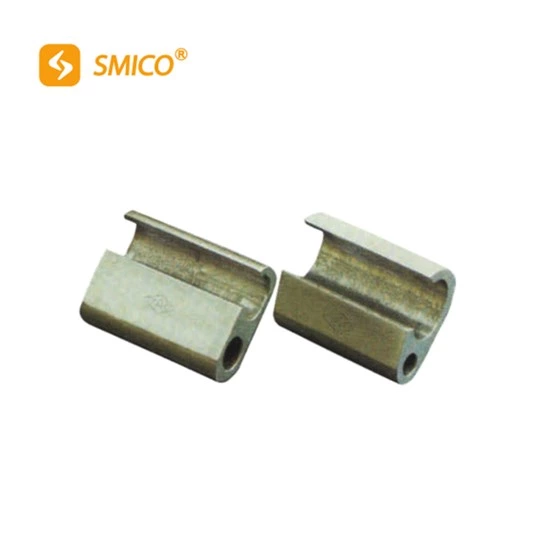Parallel Groove Clamps Are Suitable For Various Aluminum Alloy Cables, Aluminum Cables
Round copper-aluminum wire nose is suitable for various bimetal pg clamp and aluminum cables. The product can be used for photovoltaic power generation, wind power generation, power equipment connection, etc.
blackburn parallel groove clamp Introduction:
Alloy cable adds copper, iron, magnesium, silicon, zinc, boron and other alloy elements to electrical aluminum. At the same time, through process adjustment, the mechanical properties of burndy parallel groove clamp are greatly improved, avoiding the problems of low elongation, poor creep resistance and poor flexibility of pure aluminum conductors, and increasing the connection reliability of cable systems. In addition, the electrical performance of connector parallel groove is kept at the same level as that of electrical aluminum conductors, above 61% IACS.
The DC resistance assessment index of groove clamp can refer to the DC resistance value of solid conductors or stranded conductors in GB/T3956-2008 "Conductors of Cables", and there are already AA8030 and other types of rods in GB/T3954-2014 "Electrical Aluminum Round Rods".
Alloy power cables make up for the shortcomings of pure aluminum cables in the past. Although the electrical conductivity of the cables has not been improved, the bending performance, creep resistance and corrosion resistance have been greatly improved, which can ensure that the cables maintain continuous performance stability when overloaded and overheated for a long time. The use of parallel groove can greatly improve the conductivity and high temperature resistance of parallel groove clamp connector, while solving the problems of electrochemical corrosion and creep of pure aluminum conductors.
Conductivity
The conductivity of pg clamp connector is 61.8% of the most commonly used benchmark material copper IACS, and the current carrying capacity is 79% of copper, which is better than the pure aluminum standard. However, at the same volume, the actual weight of pg clamps is about one-third of that of copper. Therefore, the weight of aluminum alloy cables is about half of that of copper cables at the same current carrying capacity. Using aluminum alloy cables instead of copper cables can reduce the weight of cables, reduce installation costs, reduce wear on equipment and cables, and make installation easier.
Weight
On the premise of meeting the same electrical performance, the weight of aluminum alloy cable is half of that of copper core cable, its cross section is 1.1~1.25 times that of traditional copper core cable, and its price is 15~30% lower than that of traditional copper core cable.
Related advantages
The good mechanical and electrical properties of aluminum alloy power cable make it widely used in various fields of the national economy, such as ordinary houses, high-rise buildings, elevators, large and small supermarkets, subways, airports, stations, hospitals, banks, office buildings, hotels, postal and telecommunications buildings, exhibition halls, libraries, museums, ancient buildings, schools, power buildings, public entertainment venues, tunnels, underground buildings, warehouses, etc. It can also be used in metallurgy, steel, coke, coal mines, power plants, substations, shipbuilding, petroleum, chemicals, medicine, nuclear power plants, aerospace, military, papermaking and other industries, as well as home appliances, automobiles, public transportation facilities, etc.
Creep resistance
The alloy material and annealing process of aluminum alloy conductors reduce the "creep" tendency of conductors under heat and pressure. Compared with pure aluminum, the creep resistance is improved by 300%, avoiding the relaxation problem caused by cold flow or creep.
Tensile strength and elongation
Compared with pure aluminum conductors, aluminum alloy conductors have greatly improved tensile strength and elongation by adding special ingredients and using special processing technology. They are 30% more flexible than copper and 40% less elastic, making them safer and more reliable to use.
Coefficient of thermal expansion
The coefficient of thermal expansion is used to calculate the dimensional change of materials when the temperature changes. The thermal expansion coefficient of aluminum alloy is equivalent to that of copper. Aluminum connectors have been reliably used for copper and aluminum conductors for many years, and most electrical connectors used today are made of aluminum, which is particularly suitable for aluminum alloys. Therefore, the expansion and contraction of aluminum alloy conductors and connectors are exactly the same.
Connection performance
Electrical connections made with aluminum alloys are as safe and stable as those made with copper conductors. The composition of aluminum alloy greatly improves its connection performance. When the conductor is annealed, the added iron produces high-strength creep resistance, which can ensure stable connection even under long-term overload and overheating.
Strong self-weight bearing capacity
Aluminum alloy improves the tensile strength of pure aluminum. Aluminum alloy cables can support 4,000 meters of self-weight, while copper cables can only support 2,750 meters. This advantage is particularly prominent when wiring large-span buildings (such as stadiums).

